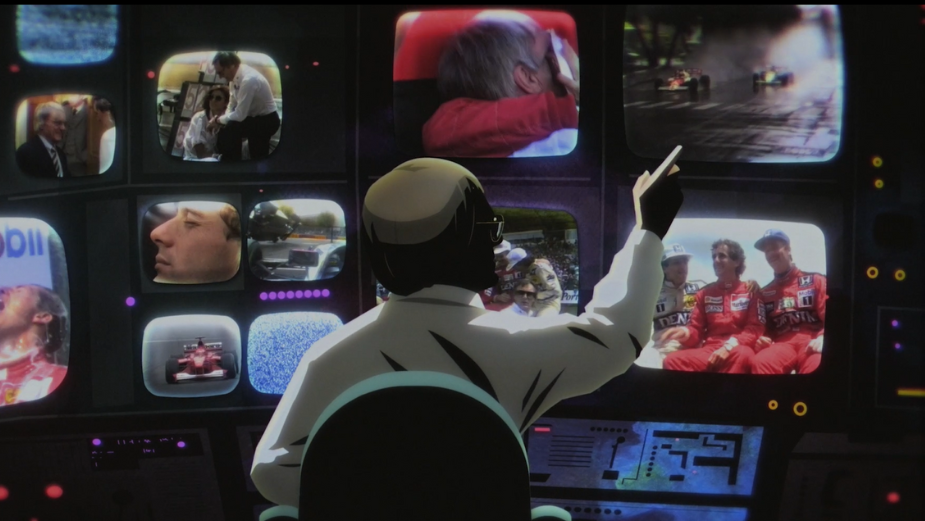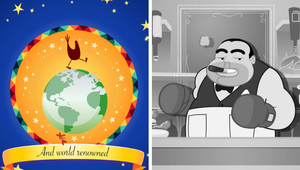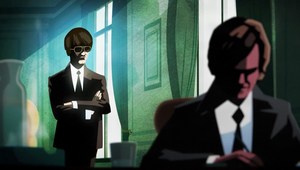
Lucky!: Capturing the Story of Formula One’s Ultimate Underdog Bernie Ecclestone

In an eight-part series airing on Discovery this Christmas Lucky! pulls back the curtain on motor racing legend Bernie Ecclestone’s incredible life and 40-year Formula One career. It’s the story of one man’s true grit and determination to overcome all the odds to create a super brand followed and adored by millions of people worldwide.
In this interview, LBB’s Sunna Coleman sits down with Jiva Maya director Manish Pandey (writer and producer of the BAFTA award winning documentary 'Senna') and the team at Kong Studio - co-founders Bill Elliott and Tom Baker, and animation producer Emma Burch - to find out what sparked the idea for the project, the creative inspiration behind the animation, and what it was like to work closely with the motor racing magnate.
LBB> Lucky! is a TV series about the incredible life and influence of Bernie Ecclestone. Manish, tell us about how the idea for this project first came to you.
Manish> I've always been nuts about motor racing - the first feature documentary I ever worked on was put together by Motor Racing Network and Bernie was involved in that too. So I kept in touch with him and in the autumn of 2019, I sent his assistant a message about my idea and he was up for discussing it. Bernie always knows if he wants to be involved or not, and he said yes which was amazing!
And then of course, covid hit. Bernie was in Brazil until summer 2020 before moving back to Switzerland. And that’s when he gave me a call that he was available to start - around 11 months after we’d initially discussed the project.
It was a tiny shoot. He owns a very beautiful hotel in Gstaad and there was a really nice bedroom with a drawing room that I thought would work perfectly. I had the idea in mind already of how I wanted to shoot him - his white hair and goatee against a white backdrop in his white shirt. Lit properly it’s almost heavenly. It worked really well.
Altogether we had seven weeks with Bernie but shot over two years. While we were putting together the interviews and the archive, a massive thing occurred to me. A real part of these stories is a kind of noir: these characters, Frank Williams, Ron Dennis, Enzo Ferrari, Ken Tyrrell, Colin Chapman - the legendary bosses of motor racing who created what is now modern Formula One - were missing. It wasn’t enough that they were in the archive. We needed to see them interacting with Bernie but that was always behind the scenes. So that’s when I thought, why don’t we animate those stories?
Each episode is 47 minutes long, about 38 being archive. Then there’s two minutes of animation in each episode. What we knew is that it had to be very bold to get the point across. From the early sketches that Kong gave us, we just knew that it would work. We didn’t want the characters to speak - the animations would be narrated by Bernie. It’s very witty and absolutely full of character.
LBB> And Kong, how excited were you to work on this project - are you a Formula 1 fans?
Tom> Who isn’t an F1 fan? It’s a massive sport and given the passage of time covered in ‘Lucky!’ we got to design and animate some amazing looking shots and bring some larger-than-life characters to life. Bernie is fascinating.
It took about a year from original contact to winning the pitch, so we were mega excited when Manish and his team chose us. You pour so much into winning a pitch like this and it’s great when the hard work is recognised by a like-minded partner.
Emma> Documentary animation was something we wanted to make more of, so I was chuffed when Jiva Maya contacted us about the project. If I’m honest, I didn’t know much about the sport, but obviously knew of Bernie. Then we learned Manish was leading the project. I’d seen ‘Senna’ and found it totally compelling. Manish’s writing and directing style is clever. He weaves stories and makes subjects accessible to people with little knowledge on them.
‘Lucky!’ was not like any other project Kong had worked, giving us the opportunity to try different styles and new crew. Not only that, while speaking to the team at Jiva Maya I realised they had respect for our craft – as we do for all the hard graft that goes into documentary making. They’re very different mediums and processes, but when combined they work so well. It was the perfect match.
LBB> What was the creative direction and what did you use for inspiration?
Bill> One of the most interesting aspects from a storytelling perspective was the very specific aesthetic Manish wanted. Bar a few exceptions, most of the scenes were the same characters sitting around tables having meetings. Initially we tried to make the shots as cinematic as possible. We mixed up the shot selection, moved the camera across characters, used the secondary characters as a framing device. Honestly, we were quite pleased with ourselves! Up until Manish saw our work… haha!
As it turned out, he had a very specific style in mind. Manish referenced the film director Derick Jarman. Each shot needed a symmetrical feel, with a vanishing point (and normally Bernie) dead centre of screen. It felt counter-intuitive at first, but it’s always exciting to have a director with a bold, clear vision. It made the finished animation style really stand out. Narratively, everything led towards the final shot, in the last episode, of an empty chair dead centre of screen. Fair play Manish!
There was a definite Noir inspired aesthetic, as part of the brief was to avoid faces, and more importantly eyes. However, the look from the pitch stage to delivery changed drastically, and in such a way that we couldn’t have seen the final look coming. For me that is one of the most exciting aspects of a collaborative art project.
Tom> Manish wanted it to be premium grown-up animation and have a bit of menace to the clandestine meetings and shadowy deals that fuel Formula 1. Dark rooms, faces hidden in shadow with artefacts that set the scene and era. We wanted to make something that looked totally awesome and that our fellow animators would not be able to work out how we made it. The final aesthetic is neo-noir, almost art deco with naturalistic movements. Some of the shots look like paintings.
LBB> What were some of the challenges and what solutions did you come up with?
Manish> Bernie is enigmatic. He's never trusted anyone to do this before. When I first filmed, he was 89 years and 11 months old. He’s got a great brain, there's no doubt about that - some of the detail that he had at his fingertips was extraordinary. But certainly, I was asking about some pretty obscure meetings. One of the challenges is literally this. He will close down on you if he feels you're a fool. He has no time for that. You really need to know what you're talking about. I had to make sure I was really well researched and on top of the material - spanning an almost 90 year life. So that was definitely one of the hardest things.
Tom> Animation-wise, there were a lot of challenges as with any job. Making sure the F1 bosses looked like the real people. Having them age appropriately throughout the decades. Making sure the locations, fashions and details were correct to the relevant moment in time. Getting it all to move…
We were lucky enough to be working with some top talent from the off with Kristian Antonelli’s original concept sketches getting us over the line on the pitch. Then Norm Konyu developed the backgrounds and Daniel Prothero the characters. We had a whole host of great animators (Rob Findlay, Mark Abbot, Jimeno Farfan, Daniel and Mick Lawrence) all backed up by Italy’s finest in the form of Daniele Baiardini and Daniele Zacchi, bringing it all together in post.
Bill> One of the other challenges was asking our crew to under-play everything. Animators want to animate exciting curves and great silhouettes, compositors want to add all the exciting bells and whistles. What we were going for was understated and low key. We had the unenviable task of telling fantastic artists to take out some beautiful work for sake of the style. Really, the shots were naturalistic moving pictures!
LBB> You worked very closely on this project - can you tell us about the collaboration and what it was like working together?
Manish> What’s great about working with Kong is that they’re much more organised than we are! The process was highly efficient. The archive footage we have can either look near pristine or very faded in places. And that’s where the animation can step in to add in a fantastic layer of colour.
There’s a moment where we see Bernie as a child from behind as German bombers converge on the London skyline which is glowing with explosions. He’s just a schoolboy, in long shorts and wearing a satchel. I think it’s one of the most brilliantly effective animations of the lot because it meant we could cut out five or so lines of dialogue and just illustrate it instead. This poor young boy experiencing the war. Pictures sometimes speak a thousand words.
The other thing we were able to do was create a visual clock to show the passing of time. With each meeting, you see certain members disappear from around the table. In episode four, we lose the first team boss, Colin Chapman. But we never refill that seat. It’s completely allegorical. It's a visual metaphor for the group of people that Bernie worked with to create this sport - that’s why we leave his chair empty. It creates tension when suddenly the table’s a bit lopsided and unbalanced. When you get to episode seven, we lose Ken Tyrrell and his chair is left empty. Then we have bosses forced to resign and you have even more empty chairs. What that forces us to do is come up with an ending that bring together the animation and what happened in reality.
Bernie has this lovely, very idiosyncratic habit that he can't leave a picture frame that's not hanging straight. So at the end we have Bernie walking up to the camera as the last person in the room, and he just adjusts the camera, moving the whole frame before leaving. It's one of the most emotional scenes you can imagine and it's done by animation.
We end the Formula One story on an animation, and that should tell you everything about how integrated that sort of storytelling is. It wasn't a cheat, it wasn't an afterthought. It became part of the storytelling.
Tom> This has probably been the best job we’ve worked on and Jiva Maya was a perfect partner. After the initial development it felt like we were all on the same wavelength and we got into the amazing work-zone where pretty much everything we did seemed to be what Jiva wanted and the changes were mostly pushing things further in the direction everyone wanted the animation to go in. It’s wonderful when a partner really ‘gets’ what it is we do.
LBB> What were your personal highlights from this project? Do you have a favourite episode?
Manish> When we were filming in Switzerland I was working alone for three weeks for various reasons. Bernie would invite me to his for lunch which I just loved. I got to watch their boy grow up - he was only ten weeks old when I first went out. I just loved seeing a different side to Bernie, having a friendly relationship which also made filming easier. It’s not often you get to meet someone who has created something that you feel so passionate about.
There’s a lot to learn from older people. I think we need to understand that as a society. A lot of them have achieved quite a lot in their lifetime so it’s a good shortcut to learn from them.
And lastly, I just love his brilliant sense of humour. I mean, he's quick. He's very, very funny.
My favourite episode was the first. It’s the purest. The pacing is extremely dramatic, not because of huge dramas, but because of how personal it is. You feel that vulnerability. The absolute horrors of the war and poverty of post-war Britain. I am captured by that part of his life - before he became the Bernie that we know.
Tom> Whenever you start these larger projects there is a fair amount of fear. Fear we may not be able to deliver what we want. Fear or miscommunication. Fear of not getting the right talent. The moment when everything clicks into place is always a great position to be in and it doesn’t always happen that way.
My favourite episode, from an animation perspective, is EP02 as this is when things started to fall into place. From then on it felt like we had a system that was delivering top quality work everyone was blown away by. EP02 had a lot of animation in it and some of the statics were super detailed works-of-art so making these move is a daunting task. We had a lot of people to align into one giant hive-mind of creativity. There were plenty of steps where things could have fallen down. It’s fantastic when you have the right team creating amazing work for the perfect partner. And the comic Bill made at the end. Bill grabbed the static images from the animation and made them into a comic which we then sent to the guys at Jiva Maya as a little treat. It looks amazing. We should make an animation from that comic. Oh wait, we already did.
Emma> A highlight for me was seeing it all come together and then being asked to make the titles sequence towards the end of our production. It meant the animation would be the first and last thing the viewer sees. It proved Jiva Maya were happy with what we had made and trusted us too. I’ll always look back on this job with very fond memories.










